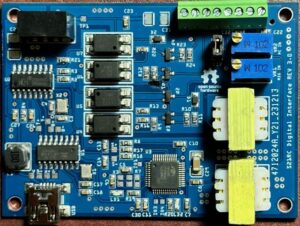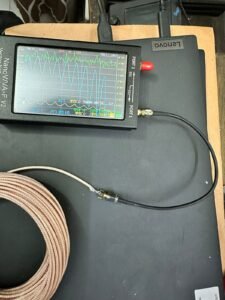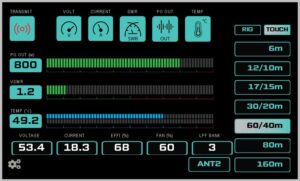When S21DW heard that I am planning to make an 3 elements short beam for 10m to replace my 2 elements 10m antenna he immediately jumped to make it asap. So, we planned to make two antennas. As I am a fan of DK7ZB design for its gain and simplicity (The first one I made with his design decades ago for 6m), I chose to make the 3m boom 3 element 28ohm yagi for 10m. Link here.
The DK7ZB measurements are given for 16mm and 12mm tube. Aluminum tube with exact measurement is difficult to get in local market here in S2, after exploring the local market we found two nearby tube which fits one inside the other – they are 15mm and 12mm.
I could follow the design and then using a VNA to adjust the elements to resonate at intended frequency, but from experience I know adjusting length for Tapper elements is not as easy as it seems. So, instead of following blindly first I modeled the DK7ZB antenna using EZNEC and then adjusted the diameters. There are two objectives: minimizing the waste of tube and getting same result as the original design. The measurement shared here is for 28.4Mhz, as we are targeting SSB phone (1:1 SWR) and also FT8 (less than 1:1.5 SWR).

Free Space:


at 20m height:

BOM:
15mm/1.5mm wall thickness tube
2x 2032mm [For Reflector and Director Center part]
2x 1006mm [For Driven Center part, 20mm gap between both element]
12mm/1mm wall thickness tube:
2x 1825mm (Reflector 1675+150mm)
2x 1691mm (Driven 1541+150mm)
2x 1522mm (Director 1372+150mm)
25x25mm Square Box aluminum: 3075mm
25×25 Angle Aluminum:
6x 75mm
2x 100mm
Plastic pipe: 21mm OD, Inside clearance 15mm
3x 150mm [for insulator]
U clamp:
6x 6mm, 25mm inside clearance. (for boom to elements)
2x 8mm, 50mm inside clearance (for boom to mast)
1x SO239 bulkhead mount socket
2x 2.5m Foam dielectric RG6 CATV cable (0.81 Velocity Factor)
Screw and rivets as needed.
RTV or silicon
2 part glue or PVC cement.
Table-1:

Preparing the elements:
Insert one of the 150mm insulation pipe at the exact center of the 15mm OD 2032mm tube. Fix it with glue. Mark the center of the insulation pipe with tape of marker pen. This will be the center piece of the reflector. Do same and prepare the director center.

Making the driven element is the tricky part. Mark the center of an insulated pipe, make two large through holes 15mm apart from the center, here we will put the screws and make the feed points. Put 15mm OD 1006mm driven elements from both sides, fix with glue. Gap between the two tubes at the center should be 20mm – tip to tip of this assembly will be 2036mm. Make two 3.5mm through holes through the aluminum tube at the center of the insulation tube holes. Here scrap the aluminum and make sure no residue of glue is there. Use two 3x25mm screw with bolt, lock washer, and normal washer. From experience we found it would have been easier if we used hex screws – L key is easier than screwdriver when working in close space.
Mark all the 12mm tube as per the table-1 measurement with permanent marker 2x for reflector, 2x for driven and 2x for director – with each element you should have 150mm extra for overlap.
Preparing the boom:
Using rivets fix the 75mm angle bracket in three positions on the boom at both sides, start from 0mm. Center of each of the three brackets should be as per the table-1 position measurement. Make holes for the U clamps to hold the elements.
Fix the two 100mm bracket with rivets, this will be 90 degrees compared to the elements bracket. Make holes for the large two U clamps to fix with the mast.

Preparing the 50 to 28ohm impedance match:
Please follow DK7ZB site, plenty of pictures and ideas. Make sure you have as little wire as possible at the antenna attachment points. The two legs of the match will be part of the driven element and should not be more than 12-15mm (ideally 10mm).
The 75ohm CATV cable we have in junk box was foam dielectric and with nanovna TDR we found the velocity factor is 0.81 – perfect for our requirement (DK7ZB advised to use 0.8 as it will improved the choke properties of the ugly current balun, 0.6 PU will work as match but will be less effective as choke balun ).
We need two 2.5m pieces of 75ohm cable of quarter wavelength (electrical length) of intended frequency.
Length = (Wavelength/4 )x V.F
So, for 28.4 MHz the size will be:
(10.55607246 /4 ) * 0.81 = 2.1376m (this is shield to shield- keep some extra as pig tail to connect the antenna elements and SO239)
After making the impedance match, we temporary put a 28ohm resistor (2 56R in parallel) at the antenna end and measured with nanoVNA, we got the dip at 28.4MHz.


We have used a plastic box so the antenna element to impedance match, and the SO239 solder sides are not drenched when it rains. But you can install without a box – but make sure you weatherproof the joints and wire ends. Use your imagination to make the center joints as you like. The total material cost of the antenna was around 40$.
Final measurement of the antenna installed at a height of 23m, measured by a nanoVNA: What a surprise, the antenna resonate exactly as the EZNEC designed frequency.

Thanks to S21FIA(Maruf), S21OD(Shawon) and S21DW(Parvez) for doing all the hard works. Without you guys it wouldn’t be possible to finish the antenna in 3 days.
NOTE: Try to make the measurements with precisions, few mm even cm in HF might not change the SWR that much – but an antenna close to its design will only ensure you get the intended gain and FB ratio.
Our make we directly used two rivets to join each 15mm with the 12mm portion as per the table-1 data – at first try we got exactly 1:1 SWR at 28.4MHz measured with a calibrated nanoVNA. I have no idea how to measure Front to Back or Front to Side ration, or the gains. As the antenna SWR exactly matched the designed frequency I assume all other parameters are good as well. The antenna is installed at 24m above ground at the corner of rooftop, first day early morning I got two NA contest station from California giving me 59, Yesterday made around 100 QSO – mostly EU and some NA stations.



